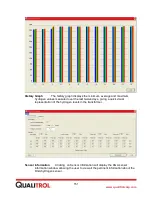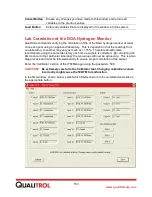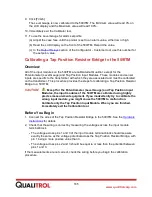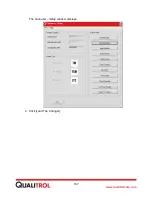
155
www.qualitrolcorp.com
Removal of
lab sample
date
This is the date when the oil was drawn from the transformer to send to a
laboratory for validation.
Load sample
Date
This locks in the hydrogen reading and the date it was taken of the oil
sample. The ‘removal of the lab sample date’ should be entered and the
load sample date button depressed as soon as possible after the oil
sample was taken to increase the accuracy of the field correlation.
Today’s
correlation
date
Once the results of the oil sample have returned from the laboratory this
is the date that the corrected value will be entered into the 509ITM.
H2 lab
correlation
value
Enter the hydrogen reading as measured by the laboratory from the oil
sample.
Load
Correlation
Once Today’s correlation date and H2 lab correlation value has been
entered, clicking on the Load correlation button will correlate the DGA
sensor to the new lab correlation value.
Cancel Button
Erases any changes you have made to this window and returns all
variables to the previous values.
Load Button
Enters all variables that are displayed in the window into the system.
Using the DGA Readings to Actuate Relays
Once the DGA sensor is installed correctly it will begin to measure hydrogen. The next step
is to decide what to do with those measurements. Interpretation of the measurement values
is dependent on a number of variables which are specific to the installation being measured:
the operating time since commissioning; the nature of the fault, equipment type, location and
temperature of the fault, solubility and degree of saturation of the hydrogen in the oil, type of
oil preservation system, the type and rate of oil circulation and the kinds of materials in
contact with the oil. Therefore it is recommended to monitor the readings daily or weekly
after start-up followed by longer intervals later on to establish baseline readings for the
particular transformer where the sensor is installed. Because of the wide variability of
hydrogen readings possible in transformers neither the IEEE nor IEC will give exact setpoint
values for identifying transformer risk but they will give guidelines for what they consider
acceptable hydrogen readings.
IEEE Std C57.104-2008
has developed a four-level set of criteria to classify risks to a
transformer when there is no previous dissolved gas history.
Condition 1: Hydrogen levels exceeding 100 ppm should prompt additional investigation.
Condition 2: Hydrogen exceeding specified levels should prompt additional investigation.
Action should be taken to establish a trend (see the standard for additional details). Fault(s)
may be present. For hydrogen levels of 101-700 PPM.
Summary of Contents for 509ITM Series
Page 26: ...26 www qualitrolcorp com Current Input Wiring...
Page 55: ...55 www qualitrolcorp com 3 Continue with the setup procedure...
Page 101: ...101 www qualitrolcorp com...
Page 144: ...144 www qualitrolcorp com The following window will appear...
Page 167: ...167 www qualitrolcorp com The Customer Setup window displays 4 Click Load Tap Changer...
Page 178: ...178 www qualitrolcorp com Appendix...
Page 179: ......
Page 180: ......
Page 181: ......
















































